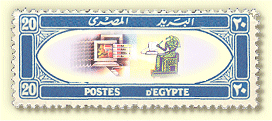PRESENT: Thirteen members and one visitor attended; apologies for absence were received from 13 members.
The Chairman regretted to have to report the absence from our late-summer Stampex meeting of three regular foreign visitors – Vahe Varjabedian (EC 390, Egypt) with chronic knee problems that meant he was immobilised, Ronny Van Pellecom (ESC 618, Belgium) with broken ribs after a fall from a ladder, and Costa Kelemenis (ESC 249, Greece) recovering from heart bypass surgery. The meeting wished them all well and a full and speedy recovery.
We had, however, one important overseas visitor in Professor Sami Fereig (ESC 569, Canada,), who was able to show us progress on his monumental new book provisionally titled A Simplified Postal History of Egypt Under the Rule of the Muhammad Aly Dynasty. In two volumes and also on CD, the book draws on his own collection first, and then on far wider sources including the co-operation of the late Peter Smith, to place and list all the post offices of Egypt during the period, to illustrate the development of their postmarks, and to analyse the advances made within the postal system during the time of Egypt’s recent royal family.
Members were fascinated by the detail available, but the author is well aware that despite years of work there remains much to be done in fine-tuning, and will welcome comments on any aspect of the volumes. He is prepared to send email copies of sections to all who might be willing to make such observations: for details please contact the Secretary.
Turning to admin, the Secretary reminded members that there were only a few days before the closing date for bids in Auction 55; and as delighted to be able to announce that Mohamed Lotfy, of Cairo, one of the Facebook “temporary” members, had chosen to seek full membership. The meeting welcomed him with acclaim. We hope that more of our Facebook friends will join him.
Spring Stampex next year (February 15-18) will have an “Ottoman Empire” theme, and the Secretary will announce particulars as soon as they are available. The organisers are keen that displays of Egypt material form an integral part of the 500-frame exhibition, and members will be invited to take part as soon as we have the full details.
On another topic, a provisional list of meetings for 2017 was drawn up; details as soon as it is in concrete form. A varied and fascinating list of “ten sheets” topics followed:
Member ESC 266 described the philatelic frenzy when it was discovered that Farouk Bar overprints could be obtained easily direct from the printers without going via the post office, leading to a plethora of “contrived” double bars covers in the 1950s – but then placed on view a lot from Auction 55 (left), a genuine small 1955 registered cover from Tala addressed to Jean Boulad d’Humières in Ismailia with a Defence 20m and double-bars Marechal 15m. Quite remarkable – and soon to honour someone else’s collection.
John Sears (ESC 188) showed a mini-collection of the sought-after Alexandria-Constanta Romanian Steamship Company covers identified by the Bir.Amb.Maritin / Alexandria/Constanta or vice-versa postmarks, together with, where possible, matching postcards illustrating the ships carrying the mails. The service, which started as the Serviciul Maritim Roman, ran from the 1910s until war stopped it in 1939.
Brian Sedgley (ESC 268) presented pages from the Posta Europea collection of the late Stanley Horesh, including five of their six postmark types (but not Type VI), together with a “mixed franking” Posta Europea entire of 22 JL 62 complete with French PO stamp and 3074 lozenge, authenticated by both Smith and Boulad d’Humières.
Ted Fraser-Smith (ESC 238) expanded on his recent article QC illustrating constant flaws on Egyptian miniature sheets with an attempt to discover the printing patterns for such sheets – and was mystified by the vast number of different sizes and shapes of the sheets. He was able to show, however, more constant varieties, especially on the sheet produced for Cairo 1991, and guidelines in the corners of many of the sheets, and hopes to be able to continue his researches using these clues.
Laurence Kimpton (ESC 591) showed several covers with Motor Mail labels produced by the Egyptian Post Office for use on the Haifa-Baghdad Nairn cars postal service, and one cover with insufficient postage for the service, which was instead sent by sea with enormous consequent delays. He also showed the lack of Baghdad postal markings for official mail carried from Iraq to Egypt by the RAF air mail service, and how mail destined for England received Egyptian stamps and cancellations for the onward part of the journey.
* The meeting was able to congratulate Laurence on the award by the American Air Mail Society of its George D Kingdom Medal for his volume Airmails across the Middle East 1918-1930, described as “the best airmail book published in 2015”.
Mike Murphy volunteered to show an astonishing recent discovery by Hisham Bassyouny (ESC 391) concerning the 6m Boy King letter sheet, which will shortly be published as a full article in the QC. In the meantime, all members should closely examine the Arabic lettering at the head of the stamp’s vignette.
Peter Andrews (ESC 122) rounded out the day with a display of the Postal Savings Bank, inaugurated in March 1901, followed four years later by the Children’s Savings Bank. He showed a block of 15 of the 5m Harrison pictorial with Epargne Scolaire CDS and a full savings form 30x5m Fuad cancelled in Alexandria 18 MRT 29. And although Feltus says of the 50m of the Second (1973-80) Savings Bank issue “apparently none were sold), Peter produced a full savings form sheet properly cancelled.
All in all, an interesting and varied afternoon in good company.
|

